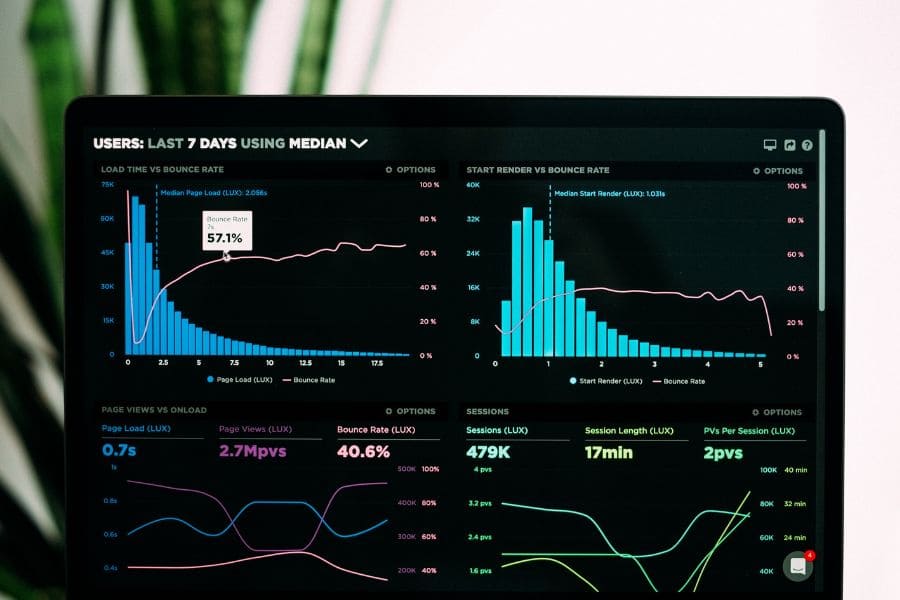Serious about email marketing? Then you already know that email marketing metrics are the key to success.
But maybe you’ve been wondering which metrics are worth your attention, and how to use them to boost conversion and gain reader loyalty. If so, you’re in the right place!
In this guide, we’ll demystify the essential email marketing metrics, and show you how to leverage this data to refine your strategies.
So if you’re ready to take your email marketing game to the next level, let’s dive in.

What is Email Marketing?
Email marketing is the use of email to promote products or services, engage with customers, and build a relationship with your audience.
It’s not just about making sales. It’s about fostering a connection that can turn a reader into a loyal customer.
Sure, there’s a lot of buzz these days about social media, but don’t let that overshadow the importance of email marketing. Most people still check their emails daily. It’s a place where you can make your message heard, loud and clear.
So if you want to learn how to upgrade your email marketing and convert your email list into paying customers, check this out!
The Importance of Email Marketing Metrics

Email metrics are the lifeblood of your email marketing strategy. They tell you what’s working, what’s not, and where you need to make changes.
And when it comes to measuring the success of your email marketing, there are three key areas to focus on:
Engagement, conversion, and retention…
Engagement
Engagement revolves around the level of interaction between your subscribers and your emails.
It’s like taking the temperature of your target audience’s interest. Are your email subscribers merely opening your emails, or are they clicking through and interacting with your content?
Conversion
Conversion is all about action.
It’s one thing for subscribers to open your emails and even click on your links, but are they taking that final step? Are they making a purchase, signing up for a webinar, or performing the desired action that your email encourages them to do?
Retention
Finally, retention is the litmus test of brand loyalty.
Are your subscribers sticking around for the long haul? Are they opening and engaging with your emails consistently over time? Or are they losing interest and hitting the dreaded unsubscribe button?
By tracking the right metrics within these three areas, you can gain valuable insights that help answer critical questions about your subscribers’ behavior.
Armed with this information, you can tailor your strategies, making them more effective, personalized, and, ultimately, more successful.
Key Engagement Metrics to Track

Engagement metrics help you understand how your audience is interacting with your emails.
They offer valuable insights into whether your emails are resonating with your audience.
Let’s take a closer look at some key engagement metrics…
1. Open Rate
The email open rate is the gatekeeper of the email marketing metrics.
As the name suggests, the email open rate measures how many subscribers are opening your emails.
It’s the first and most important sign of whether your email subject lines are capturing attention or getting lost in the crowd.
2. Click Through Rate (CTR)
Our next email marketing metric is the click through rate. This figure tells you how many people found your email content compelling enough to click on your links.
It’s like applause at a concert. The louder it gets (the higher your CTR), the better your performance (your email content) will likely resonate with your target audience.
3. Unsubscribe Rate
Next, we have the unsubscribe rate, a bittersweet email metric that shows you how many people are leaving your email list. Think of this as the breakup rate of your email relationships.
If this number starts to climb, it might be a wake-up call to reassess your email content, frequency, or overall strategy.
4. Bounce Rate
Bounce rate is our next stop.
It refers to the percentage of emails that hit a wall instead of reaching your email recipient.
Bounces can refer to hard bounces, coming from non-existent or invalid email addresses, or soft bounces, occurring due to temporary issues like a full inbox.
It’s essentially your email’s report card on deliverability, pointing out any hiccups in your email distribution process.
5. Spam Complaints
Finally, we arrive at spam complaints, a email metric that can play a major role in your email deliverability rate.
If your emails are frequently flagged as spam, your future emails may be sent directly to the spam folder, dramatically limiting your reach and visibility.
And if the spam complaints continue, you might even be barred from using certain email platforms. So this is a critical email marketing metric to keep an eye on.
By keeping a close eye on the above engagement metrics, you can gauge the quality of your interactions with your audience, paving the way for more resonant and effective email campaigns.
Key Conversion Metrics to Track

Now, conversion metrics are the detectives of your email marketing strategy, helping you uncover the effectiveness of your email marketing campaign in driving the desired actions.
These actions could be as varied as your marketing goals — making a purchase, signing up for a newsletter, downloading an ebook, or any other measurable action that serves your objectives.
6. Conversion Rate
First up is the stalwart of conversion metrics: the conversion rate.
As the name suggests, this figure tells you how many in your audience have converted from passive readers to action-takers.
In other words, conversion rate tells you how many people clicked on a link in your email and then followed through to complete a desired action.
But why is this important, you may ask?
Well, picture this: You’ve got a fishing rod, and you cast your line into the waters of your subscriber base.
The bite on your bait — that’s your click through rate, which we covered before in the engagement metrics. But what about the ones you reel in, the ones who don’t just bite but get hooked?
Those are your conversions.
7. Sales Revenue
Next, we have a metric that’s music to every marketer’s ears: sales revenue.
This metric gives you a clear picture of the return on investment (ROI) for your email marketing efforts.
By tracking the sales revenue from your email campaigns, you can see exactly how much income your emails are generating.
Imagine your email marketing campaign as a cash register.
Emails sent is like an item scanned at the checkout. The sales revenue is your grand total, showing you just how much you’ve earned from your efforts.
This figure is vital for determining the financial success of your email marketing campaigns, helping you gauge whether your efforts are translating into tangible profits.
8. Return on Investment (ROI)
We can’t talk about sales revenue without mentioning its partner in crime: ROI.
ROI describes the relationship between your sales revenue and the cost of your email marketing efforts.
Think of ROI as the financial health check of your email campaign.
Just like a doctor might check a patient’s blood pressure to gauge their overall health, the ROI gives you a snapshot of your campaign’s financial health, showing whether your investment in email marketing is paying off.
Key Retention Metrics to Track

After delving into the metrics that show us the immediate impact of our email campaigns, it’s time to look at the long game.
Retention metrics are like the historians of your email marketing, recording the long-term behavior and loyalty of your email subscribers.
Because, at the end of the day, it’s not just about making a sale; it’s about nurturing relationships and building a loyal customer base.
And that’s what retention metrics will help you do.
9. Email Sharing Rate
First on our list of retention metrics is the email sharing rate.
This metric is like the town crier of your email marketing efforts, announcing the level of enthusiasm among your subscribers. It measures how often your subscribers are sharing or forwarding your emails to others.
Why does this matter, you ask?
Because when a subscriber forwards your email, they’re not just showing their interest; they’re actively endorsing your content to others.
It’s a stamp of approval, a sign that your content is resonating so well that they’re willing to put their own reputation on the line to share it.
It’s one of the strongest indicators of subscriber loyalty and can play a key role in expanding your reach organically.
10. List Growth Rate
Next up is the list growth rate.
This metric shows you the net growth of your email list over time, taking into account new subscriptions, unsubscribes, and email bounces.
A healthy list growth rate is like a beating heart, pumping fresh life into your email marketing efforts. It’s proof that your content is continually attracting new audiences, helping to offset the inevitable attrition that comes with email churn.
By keeping an eye on this metric, you can ensure that your subscriber base keeps thriving.
11. Subscriber Lifetime Value (SLV)
Last, but certainly not least, is the Subscriber Lifetime Value, or SLV.
SLV is the fortune teller of your email marketing, predicting the total revenue you can expect from a subscriber throughout their relationship with your brand.
SLV is a comprehensive measure of subscriber loyalty and profitability, underlining the age-old truth: it’s not just about attracting new customers; it’s about keeping the old ones.
How to Track Your Email Marketing Metrics

All of the above metrics, when tracked and analyzed, provide deep insights into the health of your email marketing strategy over the long term.
They shed light on the loyalty and engagement of your subscribers, helping you to nurture these relationships and maximize your marketing success.
But now that you know what the email metrics do, how, exactly do you measure them?
Many email service providers, like Mailchimp, Brevo, or Campaign Monitor, provide a built-in email analytics dashboard.
These dashboards aggregate data from all your email marketing campaigns, helping you monitor your key email metrics in real time.
In fact, they often provide easy-to-read graphs and charts, allowing you to spot trends and patterns over time.
If you want to go a step further, you can integrate these platforms with analytics tools like Google Analytics to gain deeper insights.
Together, these tools allow you to make data-driven decisions to constantly improve your email marketing strategy.
Making the Most of Your Email Marketing Metrics

Remember, tracking email marketing metrics is your secret weapon to a powerful email marketing strategy.
You’ve taken the first, crucial step in learning about them.
Now, don’t ignore them. So, gear up, dive into those numbers in your email service provider, adjust your email strategy as necessary, and watch yourself transform your email game.
Here’s to making every email count!



